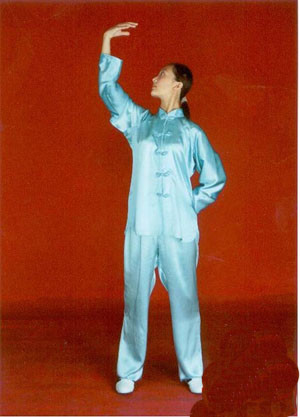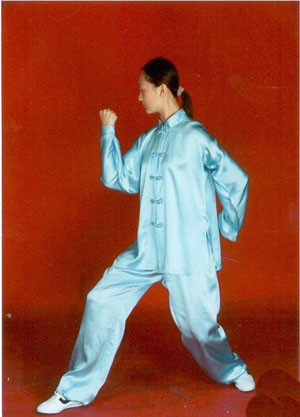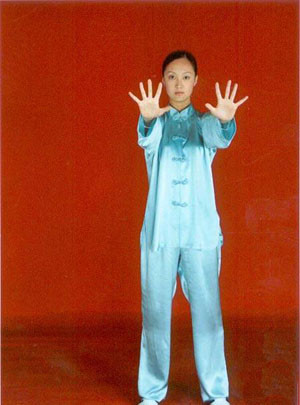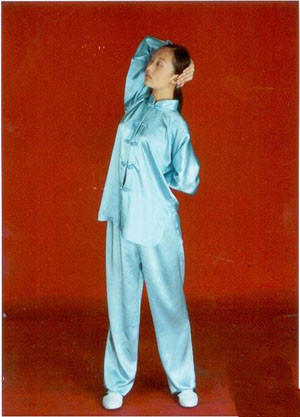
The Fourth Routine: “Plucking a Star and Exchanging a Star Cluster”
The routine contains more waist and arm rotation, so that the waist can get plenty of exercise through transition from Yang palm to Yin Palm (palm down) and coordination of waist twisting.
It is believed in traditional Chinese medicine that, the waist is the vessel of the kidney and the kidney is congenital foundation, a place for storage of congenital essence and congenital Qi that plays a key role in human growth and reproductive development. Through waist twisting and body Daoyin, as well as using consciousness, concentrating on posture, looking at the center of the palm, concentrating the mind on waist Mingmen and giving consideration to the top and bottom, lowering genuine Qi given off to the waist, kidney and Mingmen, this routine can stimulate and inspire Yang Qi and achieve the effects of strengthening the waist and kidney.
The routine requires twisting with shoulders driven by waist and arms driven by shoulders, applying strength to Mingmen and facilitating genuine Qi. As ancient people said, “the force is originated from the feet, dominated by the waist and formed at the limbs”, the waist relaxing can promote Qi and blood circulation and thus ensuring the functions dominated all activities of the entire body.

The Fifth Routine: “Pulling Nine Cows by Their Tails”
The routine drives the movements of shoulder blades while twisting the waist, which fully stimulates the acupuncture points of multiple zang and fu on the bladder meridian of foot Taiyang on the back and Jiaji Acupoint andextra nerve points. Jiaji Acupoint is a 0.5 inch acupoint lateral to the posterior midline at both sides below the first thoracic vertebrae to the fifth thoracic vertebrae spinous process of the human back, there are 17 points on the right and left, totally 34 points. It has extensive therapeutic range: the upper chest point treats cardiopulmonary diseases; the lower chest point treats spleen, stomach, liver and gall diseases; waist point treats waist abdomen and lower limb diseases. This routine exercise can effectively stimulate Jiaji and other acupoints, thus playing a very good regulation for the human zang and fu organs. On the whole, this routine contains larger amplitude of chest exercise, thus effectively stimulating Feishu and Xinshu Acupoints, having better regulation and exercise functions on heart and lung and playing better effects on prevention and control of cardiopulmonary diseases.
In addition, this routine drives the shoulders by waist, drives arms by shoulders, applies strength to the bladders through coordinated activities of the limbs and pulls fascia and meridians by rotating and stretching, thus promoting meridians and collaterals and Qi activities and regulating zang and fu functions.

The Sixth Routine: “Showing Claws and Wings”
Through a series of Daoyin movements such as arm-stretching, palm-pushing, arm-bending, palm-withdrawing, shoulder-spreading, and chest-extending, this routine enhances the lung function by smoothing Qi of chest and lung. It is believed in traditional Chinese medicine that, the lung has the physiological function of mastering Qi and managing respiration. Su Wen · Liu Jie Zang Xiang Lun also said, “The lung is the foundation of Qi”. The lung masters Qi of the entire body, the pulmonary respiratory movement can guide the opening, closing, incoming and outgoing of Qi of the entire body. Yunmen and Zhongfu Acupoints are the important acupoints of lung channel, which are located in the chest and adjacent to the lung. This routine repeatedly opens and closes Yunmen and Zhongfu Acupoints to purge the pulmonary Qi through palm-pushing and arm-spreading, thus to promote the intersection and fusion of natural air and genuine Qi inside human body and guide the opening, closing, incoming and outgoing of Qi of the entire body. In addition, Zhongfu Acupoint is where the middle-energizer Qi gather and also the front-Mu point of the lung, the gather place of Qi, Qi of the lung, and spleen and stomach are integrated in this acupoint. Thus, the exercise of this routine enables the interior and exterior Qi to well communicate.
The mental activities for the movements of palm-pushing and palm-withdrawing in this routine, the palm-pushing is required to be firstly gentle as pushing the window and then provided with overwhelming force; the palm-withdrawing is required to be as the ebb tide of seawater, for the sake of realizing coordinated form and spirit through mental Daoyin and guiding the opening, closing, incoming and outgoing of Qi of the entire body. The same goes for exhaling naturally when pushing the palm and inhaling naturally when withdrawing the palm. The lotus leaf palm (straighten and open the five fingers) when pushing the palm and willow leaf palm (straighten and gather together the five fingers) when withdrawing the palm to Yunmen are the effective ways for guiding opening and closing of Qi.

The Seventh Routine: Nine Ghosts Drawing Saber
This routine contains more body twisting and stretching and larger amplitude of back-pulling and withdrawing and twisting, therefore, the exercise positions are more extensive, especially the spinal stretching exercise. Beishu Acupoints of the five zang viscera and the six fu viscera are distributed on the bladder meridian of foot Taiyang on both sides of spinal column of the back. All the Beishu Acupoints are distributed on the first lateral-line of the bladder meridian of foot Taiyang of the back, namely, 1.5 inch lateral to the posterior midline (Du Channel). Beishu Acupoints of zang and fu organs basically correspond to the corresponding zang and fu location, e.g. the locations of the five Beishu Acupoints including Feishu, Xinshu, Pishu, Shenshu is up or down corresponding to the locations of the relevant internal organs. For example, the lung is at the highest position in the five internal organs, thus Feishu Acupoint is at the highest position in Beishu Acupoints of five internal organs; the kidney is at the lowest position, so the Shenshu is at the lowest position accordingly. Beishu Acupoints are the parts for the essence and Qi of the five zang viscera and the six fu viscera to be infused into the body surface and important acupoints for regulating functions of zang and fu organs and inspiring healthful Qi of the human body.
This routine mobilizes Qi activity of zang and fu organs and guides the opening and closing of genuine Qi of the entire body through body twisting and stretching movements especially by dint of Beishu Acupoints, thus to make the functional activities of the five zang viscera and the six fu viscera coordinated and orderly and make the ascending and descending of Qi smooth. The previous routine (“Showing Claws and Wings”) emphasizes on the opening, closing, incoming and outgoing of Qi, while this routine and the next routine (“Three Plates Falling on the Floor”) emphasize on the ascending and descending of Qi.
Through neck twisting and back twisting and stretching, this routine exercise effectively stimulates important acupoints like Yuzhen and Jiaji and contributes to the smooth of Du channel Qi activity.
(By Zhang Wenchun, Bao Xiaolei)

